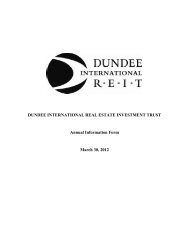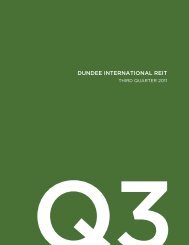Annual Report 2011 - Dundee International REIT
Annual Report 2011 - Dundee International REIT
Annual Report 2011 - Dundee International REIT
You also want an ePaper? Increase the reach of your titles
YUMPU automatically turns print PDFs into web optimized ePapers that Google loves.
DUNDEE INTERNATIONAL <strong>2011</strong> <strong>Annual</strong> <strong>Report</strong><br />
Interest rates<br />
When entering into financing agreements or extending such agreements, we depend on our ability to agree<br />
on terms for interest payments that will not impair our desired profit and on amortization schedules that do<br />
not restrict our ability to pay distributions on our Units and interest payments on our Debentures. In addition<br />
to existing variable rate portions of our financing agreements, we may enter into future financing agreements<br />
with variable interest rates. An increase in interest rates could result in a significant increase in the amount<br />
paid by us to service debt, which could limit our ability to pay distributions to unitholders and could impact<br />
the market price of the Units and/or the Debentures. We have implemented an active hedging program in<br />
order to offset the risk of revenue losses and to provide more certainty regarding the payment of distributions<br />
to unitholders and cash interest payments under the Debentures should current variable interest rates increase.<br />
However, to the extent that we fail to adequately manage these risks, including if any such hedging<br />
arrangements do not effectively or completely hedge increases in variable interest rates, our financial results,<br />
and our ability to pay distributions to unitholders and cash interest payments under our financing arrangements,<br />
the Debentures and future financings may be negatively affected. Hedging transactions involve inherent risks.<br />
Increases in interest rates generally cause a decrease in demand for properties. Higher interest rates and more<br />
stringent borrowing requirements, whether mandated by law or required by banks, could have a significant<br />
negative effect on our ability to sell any of our properties. See “Foreign exchange rate fluctuations” above.<br />
Environmental risk<br />
We are subject to various laws relating to environmental matters. Our properties may contain ground<br />
contamination, hazardous substances, wartime relics or other residual pollution and environmental risks.<br />
Buildings and their fixtures might contain asbestos or other hazardous substances above the allowable or<br />
recommended thresholds, or the buildings could bear other environmental risks. Actual and contingent liabilities<br />
may be imposed on us under applicable environmental laws to assess and, if required, undertake remedial<br />
action on contaminated sites and in contaminated buildings. These obligations may relate to sites we currently<br />
own or operate, sites we formerly owned or operated, or sites where waste from our operations has been<br />
deposited. Furthermore, actions for damages or remediation measures may be brought against us, including<br />
under the German Federal Soil Protection Act (Bundesbodenschutzgesetz). According to this Act, not only<br />
the polluter but also its legal successor, the owner of the contaminated site and certain previous owners may<br />
be held liable for soil contamination. The costs of any removal, investigation or remediation of any residual<br />
pollution on such sites or in such buildings, as well as costs related to legal proceedings, including potential<br />
damages, regarding such matters, may be substantial, and it may be impossible, for a number of reasons, for<br />
us to have recourse against a polluter and/or former seller of a contaminated site or building or the party that<br />
may otherwise be responsible for the contamination. Furthermore, the discovery of any residual pollution on<br />
the sites and/or in the buildings, particularly in connection with the lease or sale of properties or borrowing<br />
using the real estate as security, could trigger claims for rent reductions or termination of leases for cause, for<br />
damages or other breach of warranty claims against us. Environmental laws may also impose liability on us for<br />
the release of certain materials into the air or water from a property, including asbestos, and such release<br />
could form the basis for liability to third persons for personal injury or other damages.<br />
Organizational structure<br />
We hold a 50% equity interest in Lorac, which is the manager of our FCPs and the registered owner on title to<br />
our properties. Lorac is also the manager of another fund and the registered owner on title to a portfolio of<br />
properties on behalf of that other fund. We and the owner of the remaining Lorac shares have entered into a<br />
shareholders’ agreement, which provides us with the right to appoint three of the six directors of Lorac. In<br />
addition, the directors of Lorac have adopted governance rules pursuant to which, subject to applicable law,<br />
our appointed directors generally have responsibility for matters relating to our properties, and the other three<br />
directors, who are nominated by the other owner of the Lorac shares, generally have responsibility for matters<br />
PAGE 30






